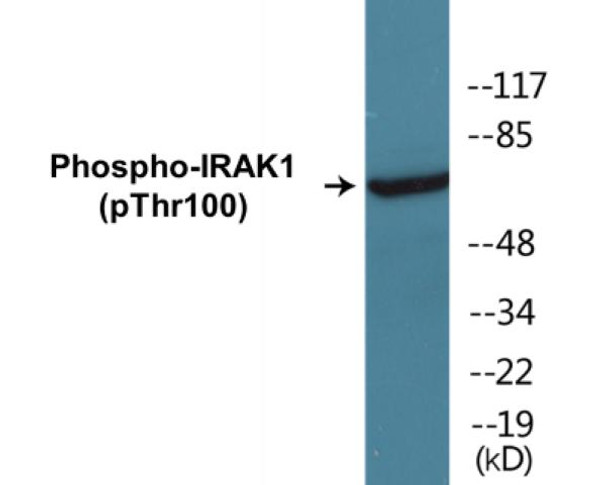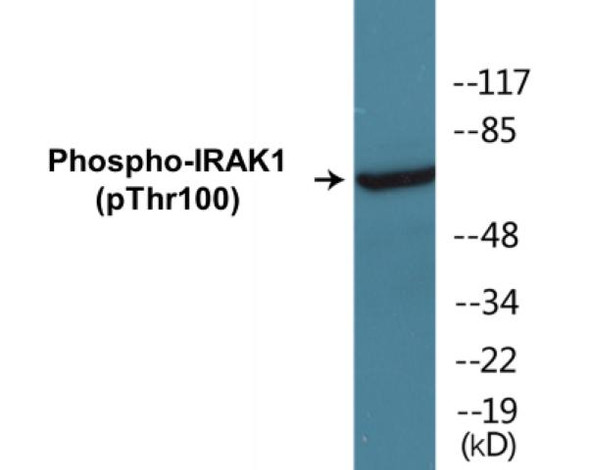Description
IRAK1 (Phospho-Thr100)Colorimetric Cell-Based ELISA Kit
The IRAK1 Phospho-Thr100 Colorimetric Cell-Based ELISA Kit is a cutting-edge tool designed for the detection and quantification of IRAK1 phosphorylated at threonine 100 in cell lysates. This kit offers exceptional sensitivity and specificity, allowing for precise and accurate measurements in a variety of cell types and experimental conditions.IRAK1 is a key regulator of the innate immune response, playing a crucial role in the signaling pathways involved in inflammation and immune system activation. Phosphorylation of IRAK1 at threonine 100 is known to modulate its activity, making it a valuable target for studying the mechanisms underlying inflammatory diseases and immune system dysregulation.
With the IRAK1 Phospho-Thr100 Colorimetric Cell-Based ELISA Kit, researchers can easily assess IRAK1 phosphorylation levels in cell lysates, providing valuable insights into the role of IRAK1 in health and disease. This kit is a powerful tool for studying inflammatory pathways, immunological responses, and potential therapeutic interventions, making it indispensable for cutting-edge research in immunology, inflammation, and related fields.
| Product Name: | IRAK1 (Phospho-Thr100)Colorimetric Cell-Based ELISA Kit |
| Product Code: | CBCAB00247 |
| ELISA Type: | Cell-Based |
| Target: | IRAK1 (Phospho-Thr100) |
| Reactivity: | Human, Mouse, Rat |
| Dynamic Range: | > 5000 Cells |
| Detection Method: | Colorimetric 450 nm |
| Format: | 2 x 96-Well Microplates |
The IRAK1 (Phospho-Thr100) Colorimetric Cell-Based ELISA Kit is a convenient, lysate-free, high throughput and sensitive assay kit that can detect IRAK1 protein phosphorylation and expression profile in cells. The kit can be used for measuring the relative amounts of phosphorylated IRAK1 in cultured cells as well as screening for the effects that various treatments, inhibitors (ie. siRNA or chemicals), or activators have on IRAK1 phosphorylation.
Qualitative determination of IRAK1 (Phospho-Thr100) concentration is achieved by an indirect ELISA format. In essence, IRAK1 (Phospho-Thr100) is captured by IRAK1 (Phospho-Thr100)-specific primary antibodies while the HRP-conjugated secondary antibodies bind the Fc region of the primary antibody. Through this binding, the HRP enzyme conjugated to the secondary antibody can catalyze a colorimetric reaction upon substrate addition. Due to the qualitative nature of the Cell-Based ELISA, multiple normalization methods are needed:
| 1. | A monoclonal antibody specific for human GAPDH is included to serve as an internal positive control in normalizing the target absorbance values. |
| 2. | Following the colorimetric measurement of HRP activity via substrate addition, the Crystal Violet whole-cell staining method may be used to determine cell density. After staining, the results can be analysed by normalizing the absorbance values to cell amounts, by which the plating difference can be adjusted. |
| Database Information: | Gene ID: 3654, UniProt ID: P51617, OMIM: 300283, Unigene: Hs.200716/Hs.522819 |
| Gene Symbol: | IRAK1 |
| Sub Type: | Phospho |
| UniProt Protein Function: | IRAK1: a TKL kinase of the IRAK family. Involved in Toll/IL-1 signaling. One of two putative serine/threonine kinases that become associated with the interleukin-1 receptor following IL-1 engagement, triggering intracellular signaling cascades leading to transcriptional up-regulation and mRNA stabilization. Extensively phosphorylated after its association with IL1-R-1. Polyubiquitinated; after cell stimulation with IL-1-beta. Polyubiquitination occurs with polyubiquitin chains linked through 'Lys-63'. Partially responsible for IL1-induced upregulation of the transcription factor NF-kappa B. Three isoforms of the human protein and produced by alternative splicing. Isoform 1 binds rapidly but is then degraded allowing isoform 2 to mediate a slower, more sustained response to the cytokine. Isoform 2 is inactive suggesting that the kinase activity of this enzyme is not required for IL-1 signaling. Once phosphorylated, IRAK1 recruits the adapter protein PELI1. Isoform 1 and isoform 2 are ubiquitously expressed in all tissues examined, with isoform 1 being more strongly expressed than isoform 2. |
| UniProt Protein Details: | Protein type:Protein kinase, TKL; EC 2.7.11.1; Protein kinase, Ser/Thr (non-receptor); Kinase, protein; TKL group; IRAK family Chromosomal Location of Human Ortholog: Xq28 Cellular Component: cytoplasm; cytosol; endosome membrane; lipid particle; nucleus; plasma membrane Molecular Function:kinase activity; NF-kappaB-inducing kinase activity; protein binding; protein heterodimerization activity; protein homodimerization activity; protein kinase activity; protein serine/threonine kinase activity Biological Process: activation of MAPK activity; activation of NF-kappaB transcription factor; activation of NF-kappaB-inducing kinase; inhibition of NF-kappaB transcription factor; JNK cascade; lipopolysaccharide-mediated signaling pathway; MyD88-dependent toll-like receptor signaling pathway; negative regulation of apoptosis; positive regulation of I-kappaB kinase/NF-kappaB cascade; positive regulation of interferon type I production; positive regulation of MAP kinase activity; protein amino acid autophosphorylation; protein amino acid phosphorylation; protein oligomerization; regulation of cytokine and chemokine mediated signaling pathway; response to lipopolysaccharide; toll-like receptor 2 signaling pathway; toll-like receptor 4 signaling pathway; toll-like receptor 9 signaling pathway; toll-like receptor signaling pathway |
| NCBI Summary: | This gene encodes the interleukin-1 receptor-associated kinase 1, one of two putative serine/threonine kinases that become associated with the interleukin-1 receptor (IL1R) upon stimulation. This gene is partially responsible for IL1-induced upregulation of the transcription factor NF-kappa B. Alternatively spliced transcript variants encoding different isoforms have been found for this gene. [provided by RefSeq, Jul 2008] |
| UniProt Code: | P51617 |
| NCBI GenInfo Identifier: | 8928535 |
| NCBI Gene ID: | 3654 |
| NCBI Accession: | P51617.2 |
| UniProt Secondary Accession: | P51617,Q7Z5V4, Q96C06, Q96RL2, D3DWW3, D3DWW4, |
| UniProt Related Accession: | P51617 |
| Molecular Weight: | 68,022 Da |
| NCBI Full Name: | Interleukin-1 receptor-associated kinase 1 |
| NCBI Synonym Full Names: | interleukin 1 receptor associated kinase 1 |
| NCBI Official Symbol: | IRAK1 |
| NCBI Official Synonym Symbols: | IRAK; pelle |
| NCBI Protein Information: | interleukin-1 receptor-associated kinase 1 |
| UniProt Protein Name: | Interleukin-1 receptor-associated kinase 1 |
| Protein Family: | Interleukin-1 receptor-associated kinase |
| UniProt Gene Name: | IRAK1 |
| UniProt Entry Name: | IRAK1_HUMAN |
| Component | Quantity |
| 96-Well Cell Culture Clear-Bottom Microplate | 2 plates |
| 10X TBS | 24 mL |
| Quenching Buffer | 24 mL |
| Blocking Buffer | 50 mL |
| 15X Wash Buffer | 50 mL |
| Primary Antibody Diluent | 12 mL |
| 100x Anti-Phospho Target Antibody | 60 µL |
| 100x Anti-Target Antibody | 60 µL |
| Anti-GAPDH Antibody | 60 µL |
| HRP-Conjugated Anti-Rabbit IgG Antibody | 12 mL |
| HRP-Conjugated Anti-Mouse IgG Antibody | 12 mL |
| SDS Solution | 12 mL |
| Stop Solution | 24 mL |
| Ready-to-Use Substrate | 12 mL |
| Crystal Violet Solution | 12 mL |
| Adhesive Plate Seals | 2 seals |
The following materials and/or equipment are NOT provided in this kit but are necessary to successfully conduct the experiment:
- Microplate reader able to measure absorbance at 450 nm and/or 595 nm for Crystal Violet Cell Staining (Optional)
- Micropipettes with capability of measuring volumes ranging from 1 µL to 1 ml
- 37% formaldehyde (Sigma Cat# F-8775) or formaldehyde from other sources
- Squirt bottle, manifold dispenser, multichannel pipette reservoir or automated microplate washer
- Graph paper or computer software capable of generating or displaying logarithmic functions
- Absorbent papers or vacuum aspirator
- Test tubes or microfuge tubes capable of storing ≥1 ml
- Poly-L-Lysine (Sigma Cat# P4832 for suspension cells)
- Orbital shaker (optional)
- Deionized or sterile water
*Note: Protocols are specific to each batch/lot. For the correct instructions please follow the protocol included in your kit.
| Step | Procedure |
| 1. | Seed 200 µL of 20,000 adherent cells in culture medium in each well of a 96-well plate. The plates included in the kit are sterile and treated for cell culture. For suspension cells and loosely attached cells, coat the plates with 100 µL of 10 µg/ml Poly-L-Lysine (not included) to each well of a 96-well plate for 30 minutes at 37°C prior to adding cells. |
| 2. | Incubate the cells for overnight at 37°C, 5% CO2. |
| 3. | Treat the cells as desired. |
| 4. | Remove the cell culture medium and rinse with 200 µL of 1x TBS, twice. |
| 5. | Fix the cells by incubating with 100 µL of Fixing Solution for 20 minutes at room temperature. The 4% formaldehyde is used for adherent cells and 8% formaldehyde is used for suspension cells and loosely attached cells. |
| 6. | Remove the Fixing Solution and wash the plate 3 times with 200 µL 1x Wash Buffer for five minutes each time with gentle shaking on the orbital shaker. The plate can be stored at 4°C for a week. |
| 7. | Add 100 µL of Quenching Buffer and incubate for 20 minutes at room temperature. |
| 8. | Wash the plate 3 times with 1x Wash Buffer for 5 minutes each time. |
| 9. | Add 200 µL of Blocking Buffer and incubate for 1 hour at room temperature. |
| 10. | Wash 3 times with 200 µL of 1x Wash Buffer for 5 minutes each time. |
| 11. | Add 50 µL of 1x primary antibodies Anti-IRAK1 (Phospho-Thr100) Antibody, Anti-IRAK1 Antibody and/or Anti-GAPDH Antibody) to the corresponding wells, cover with Parafilm and incubate for 16 hours (overnight) at 4°C. If the target expression is known to be high, incubate for 2 hours at room temperature. |
| 12. | Wash 3 times with 200 µL of 1x Wash Buffer for 5 minutes each time. |
| 13. | Add 50 µL of 1x secondary antibodies (HRP-Conjugated AntiRabbit IgG Antibody or HRP-Conjugated Anti-Mouse IgG Antibody) to corresponding wells and incubate for 1.5 hours at room temperature. |
| 14. | Wash 3 times with 200 µL of 1x Wash Buffer for 5 minutes each time. |
| 15. | Add 50 µL of Ready-to-Use Substrate to each well and incubate for 30 minutes at room temperature in the dark. |
| 16. | Add 50 µL of Stop Solution to each well and read OD at 450 nm immediately using the microplate reader. |
(Additional Crystal Violet staining may be performed if desired – details of this may be found in the kit technical manual.)






